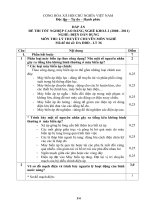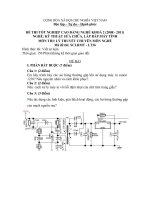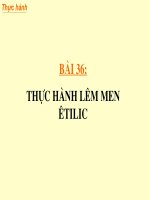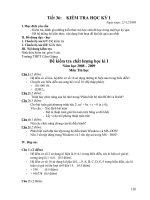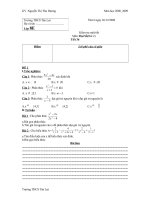PASSAGE 36
Bạn đang xem bản rút gọn của tài liệu. Xem và tải ngay bản đầy đủ của tài liệu tại đây (40.16 KB, 2 trang )
PASSAGE 36
Even before the turn of the century, movies began to develop in two major directions: the realistic and the
formalistic. Realism and formalism are merely general, rather than absolute, terms. When used to suggest
a tendency toward either polarity, such labels can be helpful, but in the end they are still just labels. Few
films are exclusively formalist in style, and fewer yet are completely realist. There is also an important
difference between realism and reality, although this distinction is often forgotten. Realism is a particular
style, whereas physical reality is the source of all the raw materials of film, both realistic and formalistic.
Virtually all movie directors go to the photographable world for their subject matter, but what they do
with this material - how they shape and manipulate it - determines their stylistic emphasis.
Generally speaking, realistic films attempt to reproduce the surface of concrete reality with a minimum of
distortion. In photographing objects and events, the filmmaker tries to suggest the copiousness of life
itself. Both realist and formalist film directors must select (and hence emphasize) certain details from the
chaotic sprawl of reality. But the element of selectivity in realistic films is less obvious. Realists, in short,
try to preservethe illusion that their film world is unmanipulated, an objective mirror of the actual world.
Formalists, on the other hand, make no such pretense. They deliberately stylize and distort their raw
materials so that only the very naive would mistake a manipulated image of an object or event for the real
thing.
We rarely notice the style in a realistic movie; the artist tends to be self-effacing. Some filmmakers are
more concerned with what is being shown than how it is manipulated. The camera is used conservatively.
It is essentially a recording mechanism that reproduces the surface of tangible objects with as little
commentary as possible. A high premium is placed on simplicity, spontaneity, and directness. This is not
to suggest that these movies lack artistry, however, for at its best the realistic cinema specializes in art that
conceals art.
Question 1. What does the passage mainly discuss?
A. Acting styles
B. Film plots
C. Styles of filmmaking
D. Filmmaking 100 years ago
Question 2. With which of the following statements would the author be most likely to agree?
A. Realism and formalism are outdated terms.
B. Most films are neither exclusively realistic nor formalistic
C. Realistic films are more popular than formalistic ones.
D. Formalistic films are less artistic than realistic ones.
Question 3. Whom does the author say is primarily responsible for the style of a film?
A. The director
B. The actors
C. The producer
D. The camera operator
Question 4. The word "shape" in line 8 is closest in meaning to________
A. specify
B. form
C. understand
D. achieve
Question 5. The word "preserve" in line 14 is closest in meaning to________
A. encourage
B. maintain
C. reflect
D. attain
Question 6. The word “They” in line 16 refers to________
A. films
B. realists
C. formalists
D. raw materials
Question 7. How can one recognize the formalist style?
A. It uses familiar images.
B. It is very impersonal.
Page 1
C. It obviously manipulates images.
D. It mirrors the actual world.
Question 8. The word "tangible" in line 20 is closest in meaning to________
A. concrete
B. complex
C. various
D. comprehensible
Question 9. Which of the following terms is NOT used to describe realism in filmmaking?
A. Simple
B. Spontaneous
C. Self-effacing
D. Exaggerated
Question 10. Which of the following films would most likely use a realist style?
A. A travel documentary
B. A science fiction film
C. A musical drama
D. An animated cartoon
ĐÁP ÁN
1-C
2-B
3-A
4-B
5-B
6-C
7-C
8-A
9-D
10-A
LỜI GIẢI CHI TIẾT
Question 1:
Thông tin trong đoạn: Even before the turn of the century, movies began to develop in two major
directions: the realistic and the formalistic = . Styles of filmmaking
Question 3:
Thông tin trong câu: Virtually all movie directors go to the photographable world for their subject matter,
but what they do with this material - how they shape and manipulate it - determines their stylistic
emphasis.
Question 4:
Form= shape: nhào nặn thành hình
Question 5:
Preserve= maintain: duy trì
Question 6:
Thơng tin trong đoạn: Formalists, on the other hand, make no such pretense. They deliberately stylize
and distort their raw materials so that only the very naive would mistake a manipulated image of an object
or event for the real thing.
Question 7:
Thông tin trong câu: They deliberately stylize and distort their raw materials so that only the very
naive would mistake a manipulated image of an object or event for the real thing
Question 8:
Tangible= concrete: cụ thể
Question 9:
Thông tin trong đoạn: We rarely notice the style in a realistic movie; the artist tends to be selfeffacing /A high premium is placed on simplicity, spontaneity, and directness.
Question 10:
A travel documentary : phim tài liệu về hành trình các chuyến đi, khám phá du lịch,vv
Page 2

